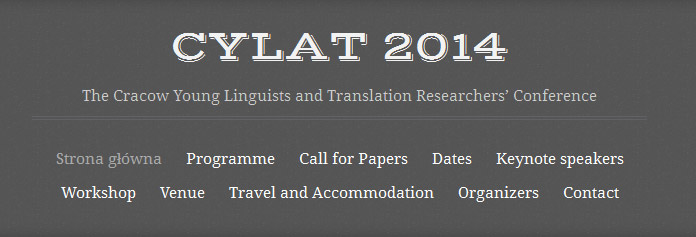II Międzynarodowa Konferencja z cyklu „The Cracow Young Linguists and Translation Researchers' Conference CYLAT”
3 kwietnia 2014 r., podczas anglojęzycznej konferencji międzynarodowej CYLAT ("The Cracow Young Linguists and Translation Researchers’ Conference"), Jan Burzyński wygłosił przygotowany wspólnie z Maciejem Czeszewskim referat pt. Why lexicographers have a problem with neologisms? (Dlaczego leksykografowie mają kłopot z neologizmami?).

Wystąpienie to stało się również okazją do zaprezentowania Obserwatorium Językowego UW doktorantom i pracownikom naukowym z zagranicy. Poniżej publikujemy abstrakt wygłoszonego referatu:
On the last year CYLAT conference we presented the theoretical assumptions underlying the project of Obserwatorium Językowe Uniwersytetu Warszawskiego, a crowdsourcing dictionary website devoted to neologisms and their cultural backdrop. This time we aim to speak about the practical consequences of these assumptions, drawn from the experience we have gained during the testing period of this online project, as well as about the history of Polish lexicographical and theoretical production concerning neologisms.
The current Polish lexicographical production lacks a dictionary of neologisms. The claim that it is impossible to write a proper dictionary of neologisms that would keep up with ongoing linguistic changes – a claim which, for the last decades, has been an axiom for linguists – is to be verified and put to question in this paper.
First, we shall examine the technological and methodological hindrances inherent in the so called „paper lexicography” – and in the lexicographical tradition in general – that made it impossible to produce such a dictionary. In this section we will also invoke and discuss our own experience of working on the first dictionary of Polish neologisms. In the period 2006-2011 we had made various attempts to publish such a dictionary under the title The Great Dictionary of New Words and Phrases.
Second, we shall try to answer the question that has come to be repeated like a mantra by Polish lexicographers, namely: what is new? At the time of „paper lexicography” the problem with answering this question has effectively immobilized every attempt at producing a dictionary of neologisms. In the introduction to his short book Nowe słowa (Bralczyk 2007), Jerzy Bralczyk writes that „it depends on what threshold of the new is assumed. For me, it is the last twenty years”. According to Bralczyk, then, even the words dated before 1987 can be viewed as new. We shall respond to this statement, as well as to the one put forward by the authors of Polnisch-deutsches Wörterbuch der Neologismen (Markowski, Vorbs 2007), and, finally, examine the works edited by Teresa Smółkowa, Nowe słownictwo polskie. Materiały z prasy lat 1985-2005, reassembled and extended as Słowa, słowa, czy je znacie? (Smółkowa 2014). We will also provide the introductory diachronic, lexicographical, referential, and, most importantly, textual and pragmatic criteria of neologization.
Third, we will show that by virtue of the recent development of information technology it is now possible to devise a dictionary of neologisms that would be able to keep up with current linguistic changes. Moreover, a dictionary whose contents – as well the very model of registration – would result not from its author’s more or less arbitrary decisions, but from an infinite discussion between language users and the editors. In fact, this model of lexicography continues the crowdsourcing tradition that has begun in the 19th century with the emergence of the noble Oxford English Dictionary. We shall briefly discuss the history as well as the more recent (and possible) developments of this concept. Our thesis on contemporary lexicography will be illustrated by our work on the forthcoming website: Obserwatorium Językowe Uniwersytetu Warszawskiego. Najnowsze Słownictwo Polskie (Mirosław Bańko, Maciej Czeszewski, Jan Burzyński eds.).
publikacja: 04.04.2014, 21.29, ostatnia aktualizacja: 20.10.2014, 22.59
















